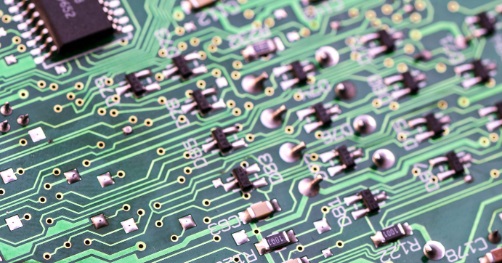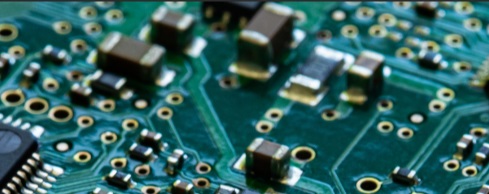What is a bare PCB?
A bare PCB is a blank printed circuit board consisting of conductive and dielectric layers, which has not yet been populated with electronic components. The production of bare circuit boards usually involves a separate set of processes called "PCB manufacturing", while the process of mounting electronic parts onto the PCB is called "PCB assembly". Bare PCBs are an important component in electronic manufacturing because they provide electrical and physical connections between electronic parts.
What is the structure of a bare PCB?
A bare PCB can be imagined as a sandwich structure consisting of layers of conductive and non-conductive materials. The largest thickness in a bare PCB is the insulating layer, which can be made of fiberglass and epoxy resin. Let’s further break down the layers of a PCB:
Copper Layer: The conductive portion of a bare PCB consists of a layer of copper. The copper layer is etched with circuit patterns to form pads and traces that allow electrical connections between components.
Prepreg: Prepreg is a layer of interwoven glass impregnated with epoxy that is partially cured in its initial state. It is pressed together with other layers by applying heat and pressure to reach its final cured state.
Core: Copper clad laminate or core is a stack of prepreg and copper foil bonded together with adhesive. Copper clad laminates can be divided into rigid copper clad laminates and flexible copper clad laminates.
Via: Vias are not strictly layers, but are still an important part of bare PCBs. Vias are drilled holes that are later plated with metal to provide electrical connections across layers.
Solder Mask: Copper that does not need to be soldered must be covered with solder mask. This is a common green material on PCBs that acts as an isolation and protection for pads.
Solder Mask: Exposed copper pads need to be protected from factors such as heat, moisture, and contamination. Since copper oxidizes easily, a metal solderable surface finish must be used. This surface finish can be gold, nickel, palladium, and silver. Other affordable alternatives include organic solder preservatives (OSP) and hot air leveling solder (HASL) >

bare pcb
What are the different types of bare PCBs?
The types of printed circuit boards vary based on the number of layers and can be broadly classified into the following categories:
Single-layer PCB. - Single-layer circuit board is the simplest and cheapest type of bare PCB as it is constructed with only one layer of conductive material. Electronic components can only be mounted on one side, which limits the functionality of the PCB. It is the easiest to design and manufacture of all types.
Double-layer PCB. A double-layer PCB has two layers of copper material on both the top and bottom layers of the PCB. Holes are drilled in the bare PCB to provide an electrical path between the two layers.
Multi-layer PCB. A multi-layer PCB has more than two layers of conductive material laminated together with a substrate and prepreg. It has a compact design and can provide high component density for high-speed applications.
Another classification of PCBs is based on the type of substrate used. The main types are as follows:
Rigid PCB: The oldest and most commonly used type of PCB is the rigid PCB. It is also the most readily available and is able to provide enhanced mechanical support for electronic components.
Flexible PCB: Widely used in medical and consumer electronics, flexible PCBs are a type of PCB that can adapt to various surfaces and shapes due to its flexibility.
Rigid-Flex. Rigid-Flex combines the advantages of the flexibility of flexible PCBs and the structural strength of rigid PCBs, providing good reliability and performance for applications that require versatile 3D configurations.
Bare PCBs can be used in a wide range of industries and applications. We need to understand the capabilities of bare circuit boards and apply them to the final product. Here are some industries that take advantage of PCBs.
Automotive electronics. With the popularity of various PCBs (rigid, flexible and rigid-flex), the functionality of vehicles has been upgraded to achieve important functions such as infotainment, safety and operation.
Medical devices Comfort, reliability and biocompatibility are key attributes that PCBs for medical applications should have. The rise of flexible PCBs in medical applications is obvious due to their easy assembly characteristics.
Commercial electronics. The internal parts of the devices we use every day, such as laptops and mobile phones, are mounted on tiny PCBs. The PCBs inside these devices are carefully designed to achieve high-speed performance and ample memory and storage space.
Aerospace. Bare PCBs for aerospace applications require high reliability performance. This means that the PCB must be able to withstand extreme stresses caused by temperature changes and mechanical shocks. Reliability testing of printed circuit boards, such as aging and thermal cycle testing, is done for
Industry. Industrial machines contain mechanical and robotic systems and require the use of PCBs, including rigid, flexible, and rigid-flex types. Bare PCBs need to be able to withstand multiple cycles and be able to effectively dissipate heat to avoid the heat generated by high-power industrial equipment.

bare pcb
Conclusion
Bare PCB board is the basic component of PCB assembly. If we do not manufacture bare boards as substrates for components, then this PCB cannot achieve the functions we want. The application fields of bare boards are becoming more and more extensive, and new types of PCBs are emerging in an endless stream. Therefore, we should also adopt new bare board technologies to meet the production needs of special PCBs. Bare board manufacturing will only become more and more complex in the future. Manufacturers and designers should pay close attention to relevant trends and changes so that they can communicate in time and produce better products.